BG Water Quest
BG Water Quest! from Black Swamp Journal on Vimeo.
Alesia Hill searching for BG’s best water on a college student budget!
BG Water Quest! from Black Swamp Journal on Vimeo.
Alesia Hill searching for BG’s best water on a college student budget!
Phosphorus pollution in Lake Erie is a big problem, and there could be a little solution: changing the dishwater detergent people use.
Detergents commonly contain phosphorus, a chemical that helps to bind dirt and remove it. Phosphorus is particularly good at binding iron, a major component of soil.
“Analyze soil and it’s mainly all iron. And phosphorus will bind the iron. So if you want to get soil out of clothing get a detergent with phosphorus and it will take it right out,” said Michael McKay, a professor of biology at Bowling Green State University.
The problem is excess phosphorus is extremely harmful to bodies of water. It causes algae blooms in lakes. Some of the most prominent cases of phosphorus pollution in Ohio are Grand Lake St. Marys near Columbus, and more recently, Lake Erie.
“It’s the algae that makes it difficult to put your hand in the water and look down and see your hand,” said McKay.
These algae blooms wreak havoc on the habitat of the waters where it grows. Too much algae in the water can lead to oxygen depletion, an affect known as hypoxia. Most fish can’t survive in water with too little oxygen and have to move to a different area of the lake, which throws off the ecosystem.
Phosphorus comes from various sources, including agriculture, wastewater treatment plants, and urban runoff.
Starting in the 1970s, phosphorus was banned in laundry detergent following a huge algae outbreak in the 1960s in lakes and rivers across the United States. In the 1950s laundry detergent contained almost 10 percent phosphorus and by the end of the 1960s it was up to nearly 15 percent phosphorus.
Lake Erie in particular had huge amounts of algae outbreaks. This created a dead zone in Lake Erie in the 1960s. Algae became so prominent in the lake that it would wash up on shores and carpet the sand green. Many fish populations in the lake drastically declined.
All 50 states of the United States now have bans on phosphorus in laundry detergent. States have begun to ban phosphorus in dishwasher detergent as well.
“When that was done back in the early 70’s, dishwashers weren’t in every kitchen like they are now,” said Peter Richards, the Senior Research Scientist at the National Center for Water Quality Research located at Heidelberg University in Tiffin, Ohio.
The laws banning phosphorus in dishwasher detergent vary state by state. “There are some states, for example, Wisconsin, that have banned phosphorus in their detergents and as a result have seen significant decreases in the phosphorus levels in their water,” said Aaron Kornbluth, who has been working on the Hypoxia Program along with the Environmental Protection Agency for the past two years.
According to the Environmental Protection Agency and a local environmental group called the Lake Erie Waterkeepers, there are currently 17 states that have banned phosphorus in dishwasher detergent, the most recent being New York.
View States with Phosphate Bans in Dishwasher Detergent in a larger map
These state bans take several years to go fully into place. For New York, phosphorus isn’t expected to be out of soap until 2013.
There is no national law making phosphorus in dishwasher soap illegal. According to the EPA, each state should know what is best for it as far as a solution for phosphorus pollution is concerned.
In the meantime the government and environmental groups are trying to find a solution to help save Lake Erie. According to Bihn, of the Lake Erie Waterkeepers, the best way to get rid of phosphorus pollution from the lake is to stop the sources. Laws that ban phosphorus in detergent help, but don’t solve the problem altogether.
Lake Erie calls people from all over to swim, boat and fish. Last summer was no exception to the fun, except for the harmful algae blooms and dead zones
that developed on the lake. Scientists are expecting Lake Erie to be in for much of the same this summer.
“Nutrients that go into the lake now are going to cause algae blooms in a couple months. We’ve certainly had a lot of rain this spring so it holds the potential for more this summer,” said Peter Richards, the senior research scientist at the National Center for Water Quality Research at Heidelberg University in Tiffin, Ohio.
Not only do algae blooms harm the lake itself, but can also keep tourists away.
“If the lake is gross, you’re going to see an effect on the local economy for lower tourism,” said Robert McKay, a scientist specializing in biology at Bowling Green State University.
A certain type of algae known as blue-green is associated with a bacteria called cyanobacteria, which can cause liver toxins to develop in humans and animals. This algae can cause health problems in elderly people, young children and pets. There were even cases where several dogs died from ingesting lake water.
“In 2010, there were 10 suspected cases of health issues resulting from contact with the algae in Lake Erie,” said Sandy Bihn, the founder and president of the Lake Erie Waterkeepers environmental group. “There were 10 also in Grand Lake St. Marys. Those seemed to be more serious.”
McKay said some of the health effects are long-term.
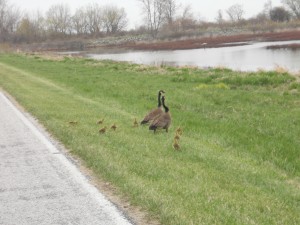
Phosphorus and blue-green algae can wreak havoc on a whole ecosystem from the bottom up. Magee Marsh is a popular breeding area for Canadian Geese and if there's a bad blue-gree algae outbreak it would prove hazardous to them as well. Photo by Kaycee Hallett
“Now are you going to get liver toxicity by having a mouth full of Lake Erie water? No. If you accumulate the surface scum and make a milkshake with it? Maybe,” McKay said.
Receiving low doses of a toxin over an extended period of time is known as chronic poisoning; cases of this have occurred with the blue-green algae in other parts of the country.
“When they’ve done epidemiological studies of areas where the inhabitants draw their water from lakes or reservoirs that have these recurring blooms of blue-green algae, there’s a higher incidence of liver cancer in those regions,” McKay said.
According to McKay, there is no evidence of this being the case in Northwest Ohio, but the blue-green algae has only been seen for the past 10 years in this region. Communities that draw water from the lake need to use extra filtration, which raises costs, Richards said.
“If the water treatment plant is using the lake for drinking water, there needs to be extra filtration which raises costs, “ Richards said.
The source of algae blooms is a nutrient necessary for all living organisms—phosphorus.
Phosphorus is one of the nutrients needed for growth. This is not only true for humans, but for animals and plants as well.
Excess levels of phosphorus cause algae to multiply like crazy. When the algae die and sink to the bottom of the lake, they are decomposed by bacteria. The bacteria use a lot of oxygen to do this, thus depleting it from the water. This causes hypoxia, a term referring to areas of water that have an extremely low level of oxygen and can no longer support life. This effectively creates dead zones.
“Any creature that is incapable of swimming away from the water will get sick or die, and any creature that is capable will swim away to different areas,
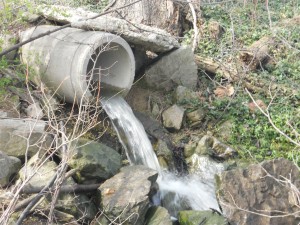
A drainage pipe releases water into the Portage River eventually to lead to Lake Erie. Photo by Kaycee Hallett
causing habitat change,” said Aaron Kornbluth, a member of the Hypoxia Program with the Environmental Protection Agency for the past two years.
Dead zones are not specific to Lake Erie. Grand Lake St. Marys near Columbus, Ohio, is an extreme case, one that will take millions of dollars to fix.
According to a recent article in the Columbus Dispatch by Spencer Hunt, $600,000 has already been allocated to clean up Grand Lake St. Marys with an additional $750,000 being added by state lawmakers. That’s over a million dollars being used to clean one lake.
Back in 2009, the toxin caused by blue-green algae was at 100 times the limit set by the World Health Organization for swimming. Last summer state officials warned people not to touch water, take boats on, or even eat fish from Grand Lake St. Marys.
“Not just Grand Lake St. Mary’s and Lake Erie but I think it was 18 other lakes in Ohio last year that the EPA found manure and other fertilizers in that were washing off into the waterways,” said Lauren Ketcham the Communications Coordinator for the Ohio Ecological Food and Farm Association, the organization that licenses organic farms in Ohio.
Ohio isn’t the only state in the nation to have this problem, and it doesn’t occur only in freshwater.
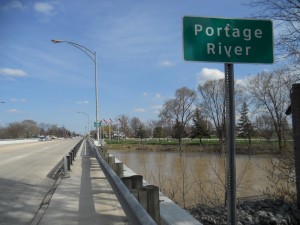
The Portage River in Woodville, Ohio runs all the way from Bowling Green to Lake Erie, passing through various farmlands along the way. Photo by Kaycee Hallett
The Gulf of Mexico is the second largest dead zone in the world, Kornbluth said. “Last measured, it was the size of the state of Massachusetts,” said Kornbluth.
According to Kornbluth and the EPA, phosphorus is a major factor in the Gulf of Mexico dead zone. Most of this phosphorus comes from the Mississippi River.
Kornbluth said that the EPA estimates roughly 43 percent of agriculture runoff along the Mississippi River ends up in the Gulf of Mexico.
During the spring months, snow melts and rain falls, carrying farm runoff into the river. In the 90 days it takes for the Mississippi River to run from Minnesota to the Gulf of Mexico, enough phosphorus is collected to create massive algae blooms, and when those algae blooms die in early summer, the dead zone is created.
Phosphorus that comes from agricultural resources is referred to as non-point source phosphorus. It is diffused and harder to pinpoint, Kornbluth said.
Because the land in this region is used primarily for agriculture, most farmers are working to decrease any runoff.
“They’re making a living off that land. If they were abusing it or doing things that would attribute to the runoff or soil erosion, that’s the best soil that erodes and washes away down the streams. And if it carries nutrients, they have to replace those nutrients at the best time of the year so they’re wasting money,” said Allen Gahler, the organization director for the Ottawa, Lucas and Wood County chapters of the Ohio Farm Bureau.
The Ohio Farm Bureau encourages its members to do frequent nutrient tests to see what nutrients need to be added to the field and how much. That way, there won’t be excess chemicals to runoff into the tributaries that head towards Lake Erie.
“In Ohio, you’re allowed to apply liquid manure on frozen grounds, and it runs off when the ground melts and gets into the streams,” Bihn said.
The best time to apply fertilizer to the fields, as far as reducing runoff is concerned, is the spring after the snow melts. However, this is difficult for some farmers because most of the fertilizing is contracted to companies who come and apply it for them. This means there is limited equipment for an entire area, and it is difficult for every field to be done in the same period of time.
“If it’s cold and wet and rainy, and if you have one person applying the nutrients and they’ve got to be 10 places at one time, they just can’t do that. There’s just some limitations on how the industry is set up now,” said Larry Antosch, the senior director for Program Innovation and Environmental Policy for the Ohio Farm Bureau.
Several scientists believe that fertilizer being placed on the fields in the fall or winter is a contributing factor to the current trend: total phosphorus levels are decreasing nationally while the amount of what’s called “dissolved reactive phosphorus” is increasing. Dissolved reactive phosphorus is phosphorus that’s already broken down in the water and is readily usable for plants and algae, making it easier for algae blooms to occur.
“Farmers recognize that there’s a problem. Obviously with Grand Lake St. Marys, and then even the algae blooms we saw in Lake Erie this year, the entire industry as well as the general public should recognize that there may be issues that need to be addressed. But farmers are not going to stand up and say ‘It’s completely our fault. It’s got to be our fault. So regulate us and that will take care of it’,” Gahler said.
Farmers have not changed their agricultural practices drastically. According to the Ohio Farm Bureau, over the past few years, there hasn’t been any significant change in land usage or livestock numbers that would promote this increase in dissolved reactive phosphorus.
“There is some evidence that the amount of the dissolved reactive phosphorus is increasing although the amount of the application in the agricultural usage is decreasing,” said Kornbluth.
Phosphorus also comes from other places including wastewater treatment plants and other urban runoff. Wastewater treatment plants are referred to as
point sources because they are large and easily identified. The mix of runoff from urban and rural sources depends on the area.
“In Chesapeake Bay, in Washington, D.C., much more of the contribution of phosphorus is coming from urban and population sources: 52 percent as opposed to the 12 percent in the Gulf of Mexico,” said Kornbluth.
The EPA, which regulates the amount of phosphorus wastewater treatment plants can release into the waterways.
“Each plant has different standards; most are somewhat similar, but since we’re going straight to the river, our standards are fairly strict,” said Matt Cox, a chemist at the Bowling Green Wastewater Treatment Plant.
Not all plants are required to meet standards for phosphorus output. According to the EPA, there are roughly 16,500 wastewater treatment plants and fewer than 10 percent are required to meet standards on phosphorus.
The EPA relies on the states to decide what is necessary, as far as what restrictions are needed in the wastewater treatment plants. If the states don’t believe that a certain area needs control on phosphorus than that plant will not have phosphorus requirements.
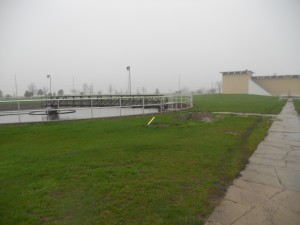
A filtration tank on the ground of the Bowling Green Wastewater Treatment Plant. Photo by Kaycee Hallett
“It’s been a very wet spring and that’s been kind of playing havoc with the way we do things. We change the flow around a little bit from the winter rains to treat the higher flow and effectively treat it,” said John Bella, the assistant superintendant at the Bowling Green Wastewater Treatment Plant.
The Bowling Green plant meets its standard set by the EPA of one milliliter of phosphorus with every liter of water released. Even during rainy springs like this year, roughly 0.7 milliliter of phosphorus per liter of water is coming out of the plant, and less in the summer. Not every plant in the nation does as well.
“Places like the Detroit Wastewater Plant have billions of gallons of sewer overflows that go into Lake Erie every year. In the 1970’s, it was the single largest phosphorus source from a single point source in Lake Erie,” Bihn said.
According to The Great Lakes Report, in 2009 alone, the Metro-Detroit Wastewater Treatment plant released more than 37 billion gallons of sewage overflow into the Detroit waterways, eventually making its way to Lake Erie.
“The estimation to upgrade all of the wastewater treatment facilities nationally to achieve more technology-based limits would be $45 billion to bring the treatment plants down to .1 milligram of phosphate,” Kornbluth said.
Whatever the source of the phosphorus, enough of it is finding its way into Lake Erie every year to cause blooms of blue-green algae. As a result, the environment changes.
“You have an increased amount of nutrients – phosphorus and nitrogen -getting into the system. Over time, the amount of nutrients that stay in the area increases and the ecosystem becomes more and more sensitive to the nitrogen and phosphorus,” Kornbluth said.
If things stay the same, we’ll continue to have the same kinds of problems we do right now,” Richards said.
“The reality is that Lake Erie is getting greener every year and the algae problem in Lake Erie is getting worse every year,” Bihn said. “There are ways we can work to help save Lake Erie and clean the water, but pointing fingers at each other takes up time and doesn’t get the problem solved.”
24th Annual Reddin Symposium from Black Swamp Journal on Vimeo.
Scientists from Canada joined Bowling Green State University professors for the 24th Annual Reddin Symposium. This year’s conference addressed the decreasing health of the Great Lakes.
Lake Erie may be on the verge of dying. Again.
In the 1960s, Lake Erie was proclaimed to be “dead.” The lake was full of algae and pollution, which led to many fish dying and tourists fleeing the beaches. Scientists identified phosphorus, a chemical which causes excess amounts of algae to grow, as being the culprit.
Many scientists predicted that the lake would recover completely, especially after the passing of the Great Lakes Water Quality Agreement in 1972 between the United States and Canada, which attempted to control the amount of phosphorus going into the lake. They were wrong. Lake Erie on its way to being completely dead once again.
John Gannon, a limnologist of Windsor, Canada, spoke on problems facing Lake Erie at the Reddin Symposium on Jan 22, at Bowling Green State University. Gannon is retired from the International Joint Commission Great Lakes Regional Office in Windsor.
Gannon shared his concern about the current levels of phosphorus in the lake. Phosphorus enters the lake through runoff from the rivers flowing through farms and cities. Phosphorus is necessary in the lake for feeding the plants and animals that call the it home. When the amount of phosphorus exceeds the needed amount to feed the organisms, it becomes a problem. Too much phosphorus may cause algae to run rampant in the lake. When the algae decomposes, it sinks to the bottom of the lake where it proceeds to absorb all of the oxygen, which leads to a “dead zone.” Fish are unable to survive in an area that does not have enough oxygen, which is what gives the dead zone its name.
The buildup of phosphorus in the lake is called eutrophication .
According to Gannon, during the ‘60s, scientists did studies on the water quality and fish, which is how the large amounts of phosphorus were identified as being the unbalanced nutrient in the lake. The public wanted action taken, which led to the water quality agreement. Many bans were placed on phosphorus in detergents.
The amount of phosphorus that declined in the lake in the 1970s and improved the water quality immensely, began rising again in the past several years, which has led to an increase in algae.
The dead zone is not the only problem facing Lake Erie at this time. Another key problem is the introduction of
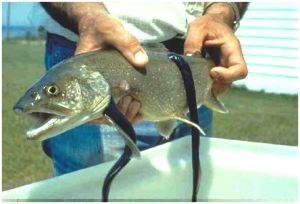
Very few fish are able to survive the attacks of the sea lamprey, such as the one shown here. Photo courtesy of John Gannon.
invasive species. Invasive species are non-native plants or animals that have strong effects on their new ecosystem. An example of this is the sea lamprey. It is the oldest recorded invasive species in the Great Lakes, and as few as one in seven fish survive its attacks, according to Gannon.
Toxic chemicals, unplanned growth, habitat destruction and climate change have also had a massive effect on the lake over the years.
The Lake Erie Water Quality Agreement is currently being revised, after nearly 40 years. Gannon said that people can help out by supporting the negotiations and revisions concerning the agreement. They can also reduce the amount of household products they use that contain phosphorus, as well as lawn fertilizers containing the chemical.
“Give the Earth a chance. It will restore itself,” Gannon said.
For more information on the agreement between the United States and Canada see, http://binational.net/home_e.html